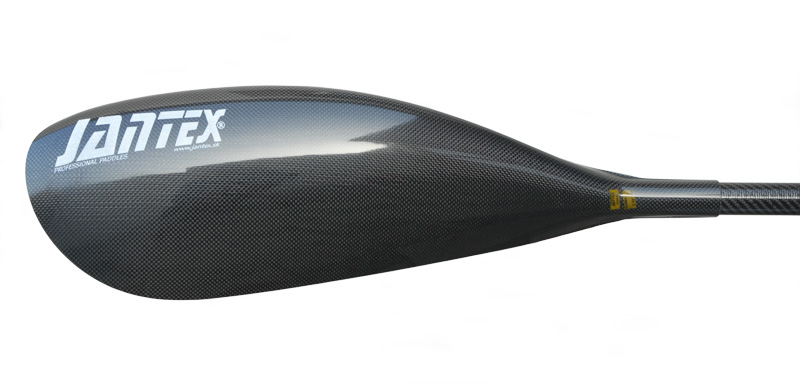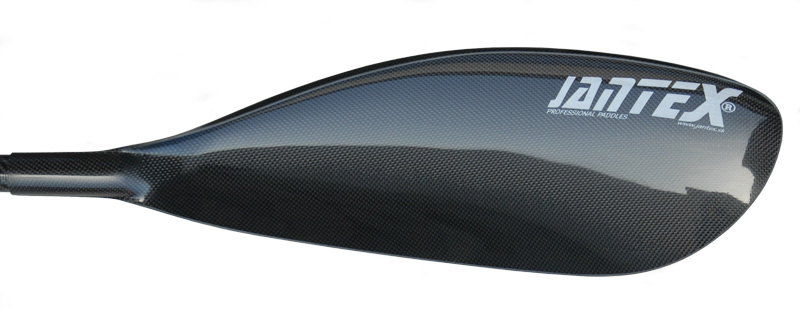Select A Discipline
Sprint Canoe
Sprint, or Flatwater, racing is one of the oldest Olympic sports. This is where you will find the “Fastest Male and Female Paddler on the Planet”! It is a classic test and combination of speed, explosive power, endurance, and balance. The basics of sprint racing are simple: fastest paddler who stays in their lane, upright, wins. The Sprint discipline utilizes two classes of boats: canoe and kayak. Each is considered its own sub-discipline.
Sprint, or Flatwater, racing is one of the oldest Olympic sports. This is where you will find the “Fastest Male and Female Paddler on the Planet”! It is a classic test and combination of speed, explosive power, endurance, and balance. The basics of sprint racing are simple: fastest paddler who stays in their lane, upright, wins. The Sprint discipline utilizes two classes of boats: canoe and kayak. Each is considered its own sub-discipline.
The Sport of Olympic Canoeing – or more accurately, Canoe/Kayak – made its debut in the Olympic Games as exhibition events in 1924. There were six events for men only – three canoe events and three kayak events. The French Olympic Committee, as hosts of these Games, asked the Canadian Olympic Committee to demonstrate the sport in Paris. Races were arranged between the Canadian Canoe Association and the Washington Canoe Club from the United States. Events were held for each of 1, 2, and 4 oarsmen for both single-end paddles (modern canoe style) and double-end paddles (modern kayak style). With the success of this exhibition, the International Olympic Committee (IOC) added Canoe/Kayak to the official Olympic program for the 1936 Games.
There are currently 12 flatwater sprint events on the Olympic Program.
Sprint canoe (or single blade/high kneel) is also known as “Canadian” canoeing, given that Canada introduced the sport to the Olympics. This discipline requires the paddler to kneel on one knee, with the kneeling leg’s foot behind the paddler and the opposite leg and foot placed out in front of the paddler in the canoe for balance and support. Athletes paddle only on one side to propel themselves down the course.
Between 1936-2016, the Olympic Sprint Program included singles (C1) and doubles (C2) canoe events for men only. There have been no women’s canoe events in the Olympics, however, on June 9, 2017, the IOC announced the inclusion of 3 women’s canoe events for the Tokyo 2020 Olympic Games, with 2 for Sprint (C1 200-meter and C2 500-meter events). “C” stands for “Canadian”, respecting Canada’s gift to the Olympics in 1924.
Women’s C1 200: 2019 Canoe Sprint World Cup 2, Duisburg
*race starts at 6:15
Women’s C2 500: 2019 Canoe Sprint World Cup 2, Duisburg
*race starts at 2:00
Women’s C2 200: 2019 Canoe Sprint World Cup 2, Duisburg
*race starts at 58:30
Women’s C1 500: 2019 Canoe Sprint World Cup 2, Duisburg
*race starts at 1:25:00
Men’s Sprint Canoe Videos

The canoe is an open deck boat (i.e., the majority of the boat is open with only short decks on top of the canoe in the front and back. The single person canoe is a maximum of 17 feet (or 5.2 meters) long, 11-12 inches (or 28-30 cm) wide with a minimum weight of 14kg (or 30.9 pounds) and is steered using a “J” stroke and other paddle maneuvers to keep the boat on course.
*Source: Nelo
Athletes use a paddle with a single blade to propel the boat forward. The paddle is usually slightly shorter than the height of the athlete – though it is always personal preference. The paddle includes a straight shaft with a single blade on one end and a “T” grip handle on the other end of the shaft. Sprint Canoeists paddle on one side only.
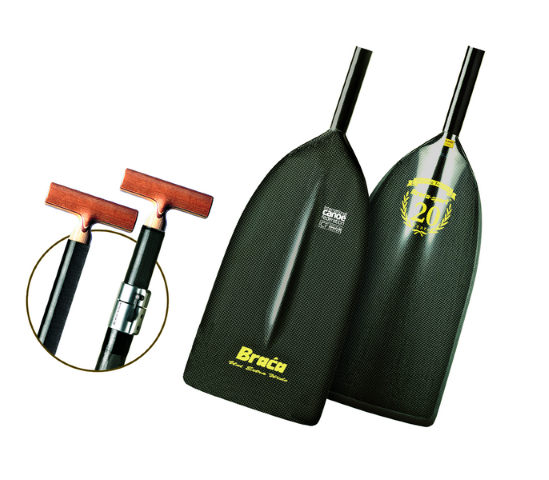
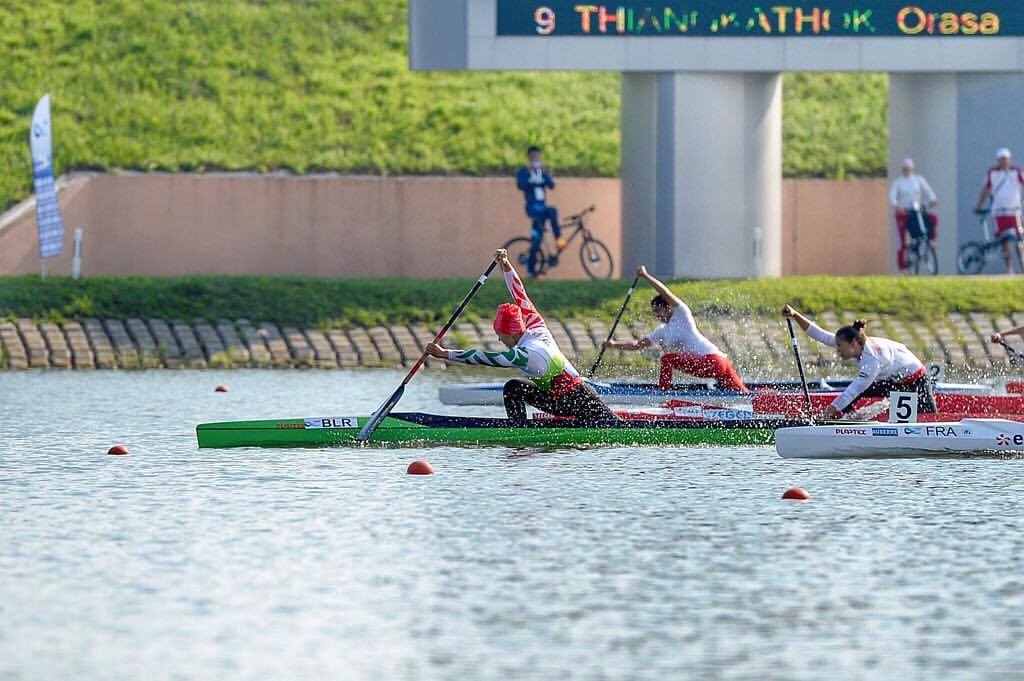
*Source: Braca-sport
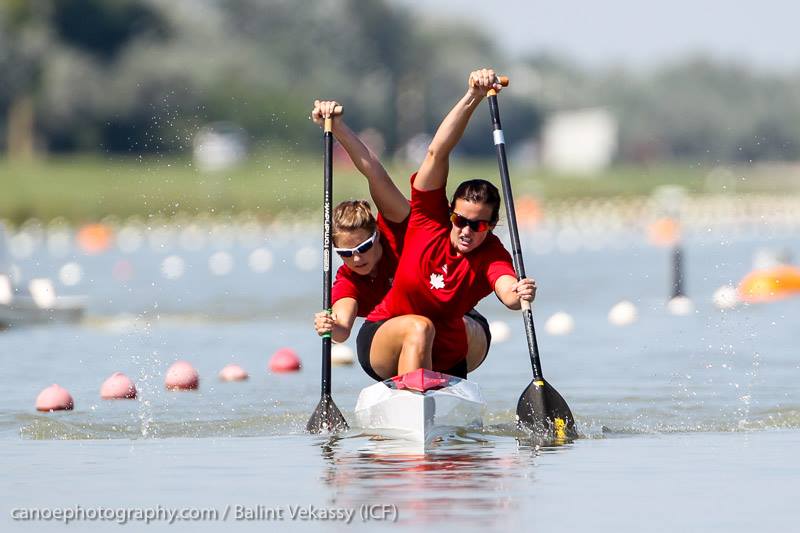 For Tokyo 2020, Olympic distances are 200m, 500m and 1000m for men, and 200m and 500m for women, in one, two and four person kayaks. For canoe, Olympic distances are only 1000m for men and 200 and 500m for women as women’s canoe makes its debut. International races range from 200m to 5000m for men’s canoe, however, women canoeists still do not compete in the 1000m event and do not have 4 person canoe (“C4”) events. Women’s C4 is competed at the national level throughout the world.
For Tokyo 2020, Olympic distances are 200m, 500m and 1000m for men, and 200m and 500m for women, in one, two and four person kayaks. For canoe, Olympic distances are only 1000m for men and 200 and 500m for women as women’s canoe makes its debut. International races range from 200m to 5000m for men’s canoe, however, women canoeists still do not compete in the 1000m event and do not have 4 person canoe (“C4”) events. Women’s C4 is competed at the national level throughout the world.
At the World and other international levels, race distances are 200, 500, 1000, 5000, respectively, for the men’s and women’s kayak classes and men’s canoe (C1, C2, C4). These classes each have 8 events. Women canoeists at the Senior level competed in only two events up until 2018 (C1 200m and C2 500m) when the program was expanded to include C1 500, C2 200 and C1 5000m events.
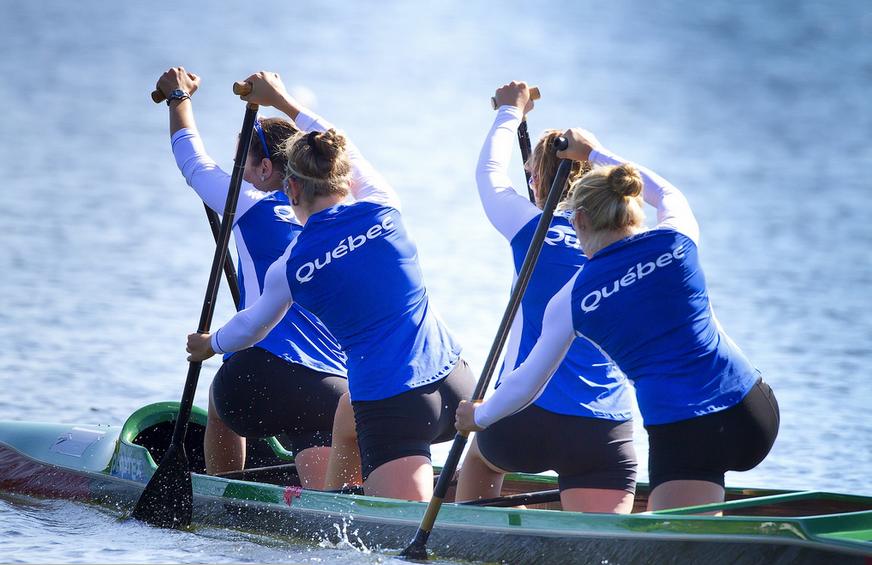 International (World level) races are competed on a straight, buoyed flatwater course with 9 lanes, each boat in a separate lane. The Olympic Games is an exception, with races comprising 8 lanes.
International (World level) races are competed on a straight, buoyed flatwater course with 9 lanes, each boat in a separate lane. The Olympic Games is an exception, with races comprising 8 lanes.
The aim of a sprint competition is for paddlers to race each other in their respective sub-disciplines (canoe and kayak) over a clearly defined straight and unobstructed buoyed course in the fastest according to the Canoe Sprint Rules of the International Canoe Federation (ICF).
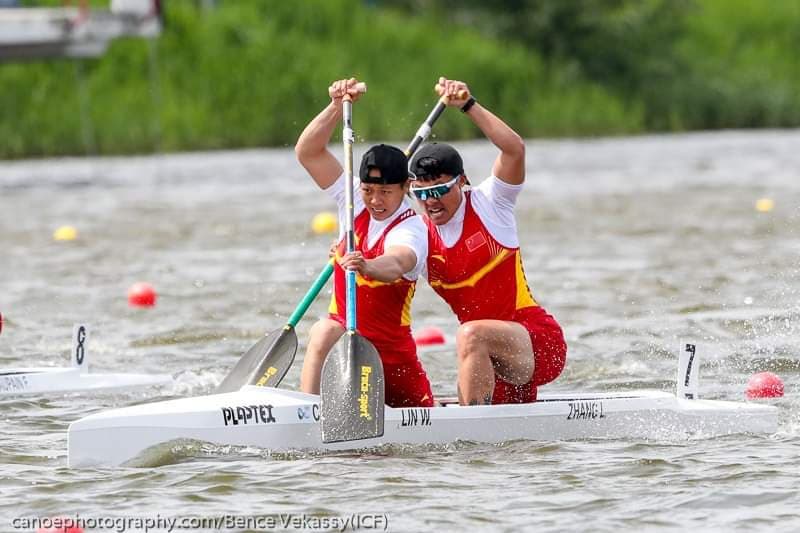 See complete ICF Rules and Statutes for Slalom and Sprint.
See complete ICF Rules and Statutes for Slalom and Sprint.
Photo credits to Balint Vekassy, where noted.
Sprint Kayak
Sprint, or Flatwater, racing is one of the oldest Olympic sports. This is where you will find the “Fastest Male and Female Paddler on the Planet”! It is a classic test and combination of speed, explosive power, endurance, and balance. The Sprint discipline utilizes two classes of boats: canoe and kayak. Each is considered its own sub-discipline.
Sprint, or Flatwater, racing is one of the oldest Olympic sports. This is where you will find the “Fastest Male and Female Paddler on the Planet”! It is a classic test and combination of speed, explosive power, endurance, and balance. The Sprint discipline utilizes two classes of boats: canoe and kayak. Each is considered its own sub-discipline.
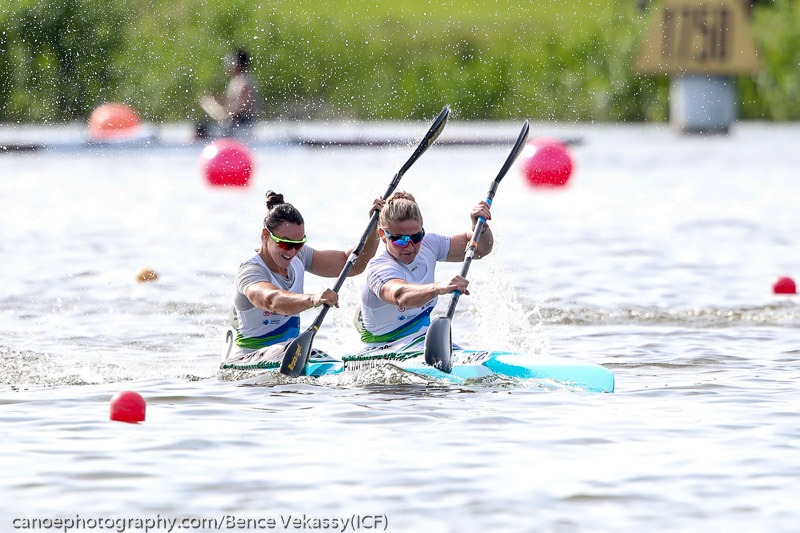 Kayaking requires the paddler to sit on a seat in a boat that has an almost entirely closed deck, however, there is enough of an opening for the paddler to sit in the kayak, on a seat with knees visible. The aim of a sprint competition is for paddlers to race each other in their respective lanes, over a clearly defined straight and unobstructed buoyed course, in the shortest possible time.
Kayaking requires the paddler to sit on a seat in a boat that has an almost entirely closed deck, however, there is enough of an opening for the paddler to sit in the kayak, on a seat with knees visible. The aim of a sprint competition is for paddlers to race each other in their respective lanes, over a clearly defined straight and unobstructed buoyed course, in the shortest possible time.
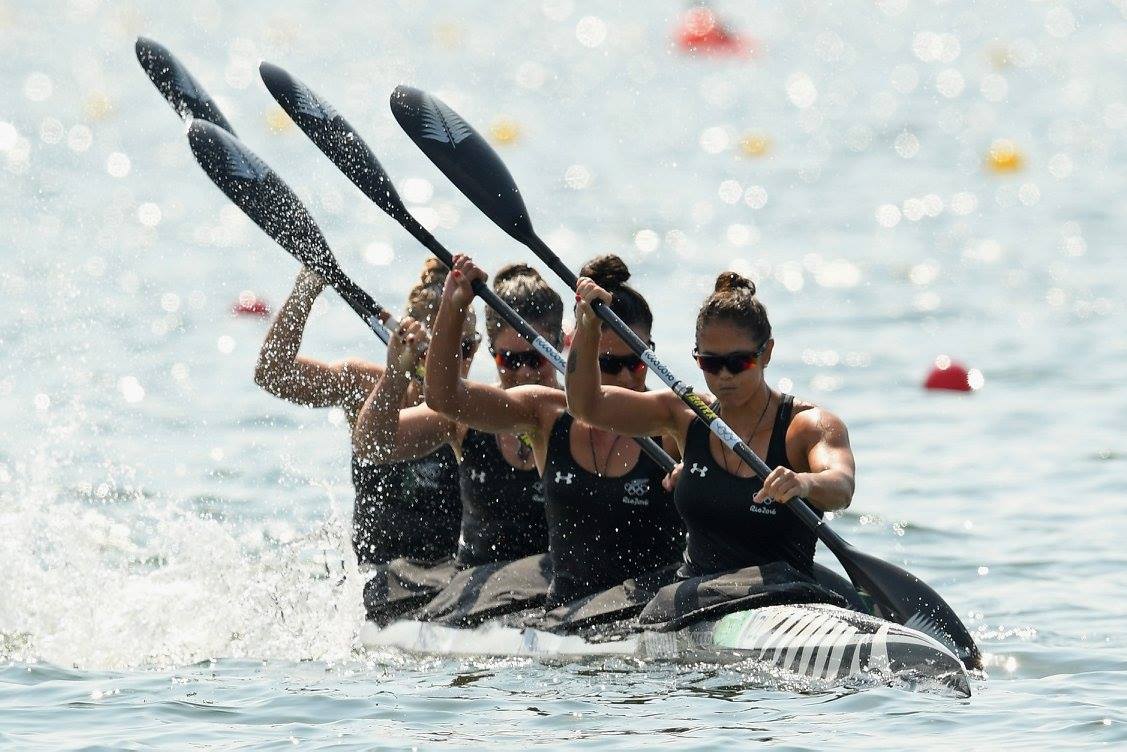 The Olympic Sprint Program includes singles (K1), doubles (K2) and four-person (K4) kayak events for men and women. “K” stands for Kayak.
The Olympic Sprint Program includes singles (K1), doubles (K2) and four-person (K4) kayak events for men and women. “K” stands for Kayak.
Women’s K1 200
Women’s K1 500
Women’s K2 500
Women’s K4 500


Single-person Sprint Kayaks are a maximum of 17 feet long, approximately 11 inches wide with a minimum weight of 12kg (or 25 pounds). In the closed-in area over the bow and/or stem of a canoe or kayak, is intended to shed water and strengthen the gunwales. The kayak has a rudder for steering (using the feet), as opposed to the canoe – which has no rudder. In two- and four-person kayaks (K2 and K4), the paddler in the first seat controls the steering. See ICF Rules regarding boat construction.
*Source: Nelo Kayaks
The paddler uses a double blade paddle (a blade on both ends of the straight shaft) and propels the boat forward paddling on both sides.
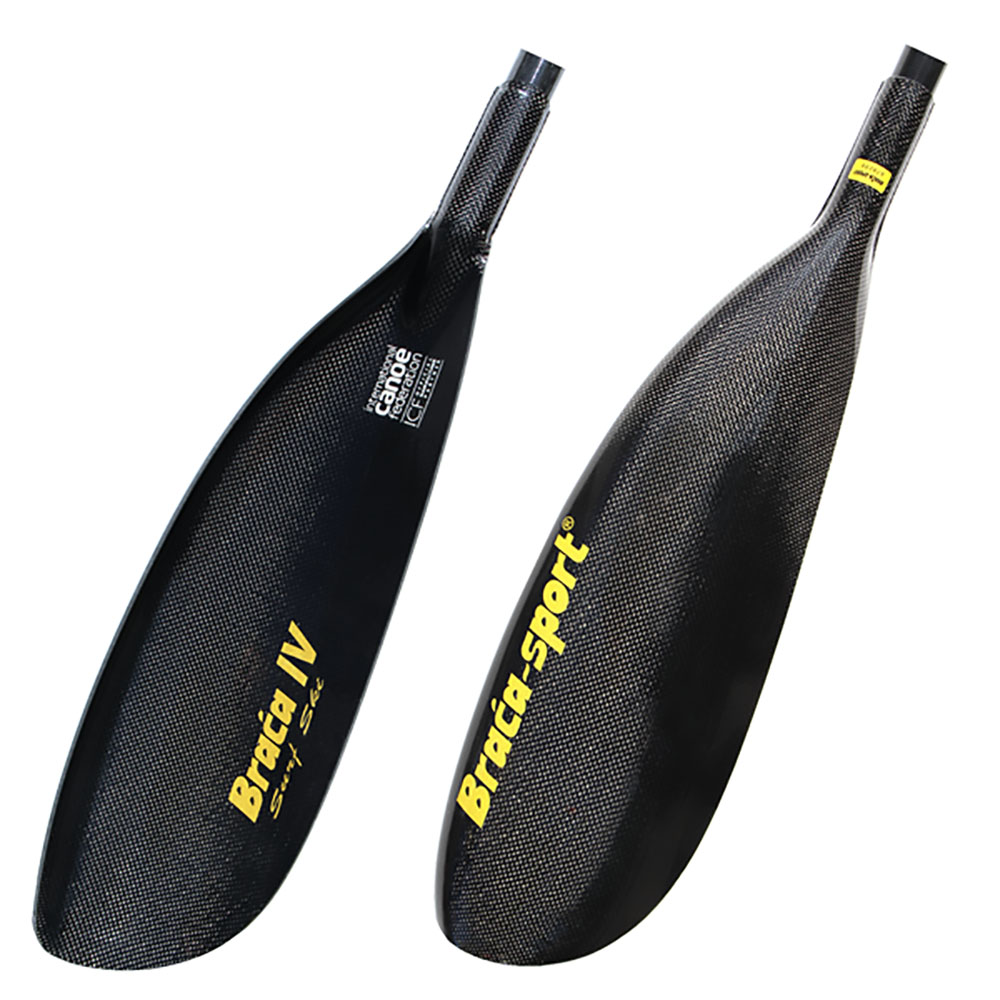
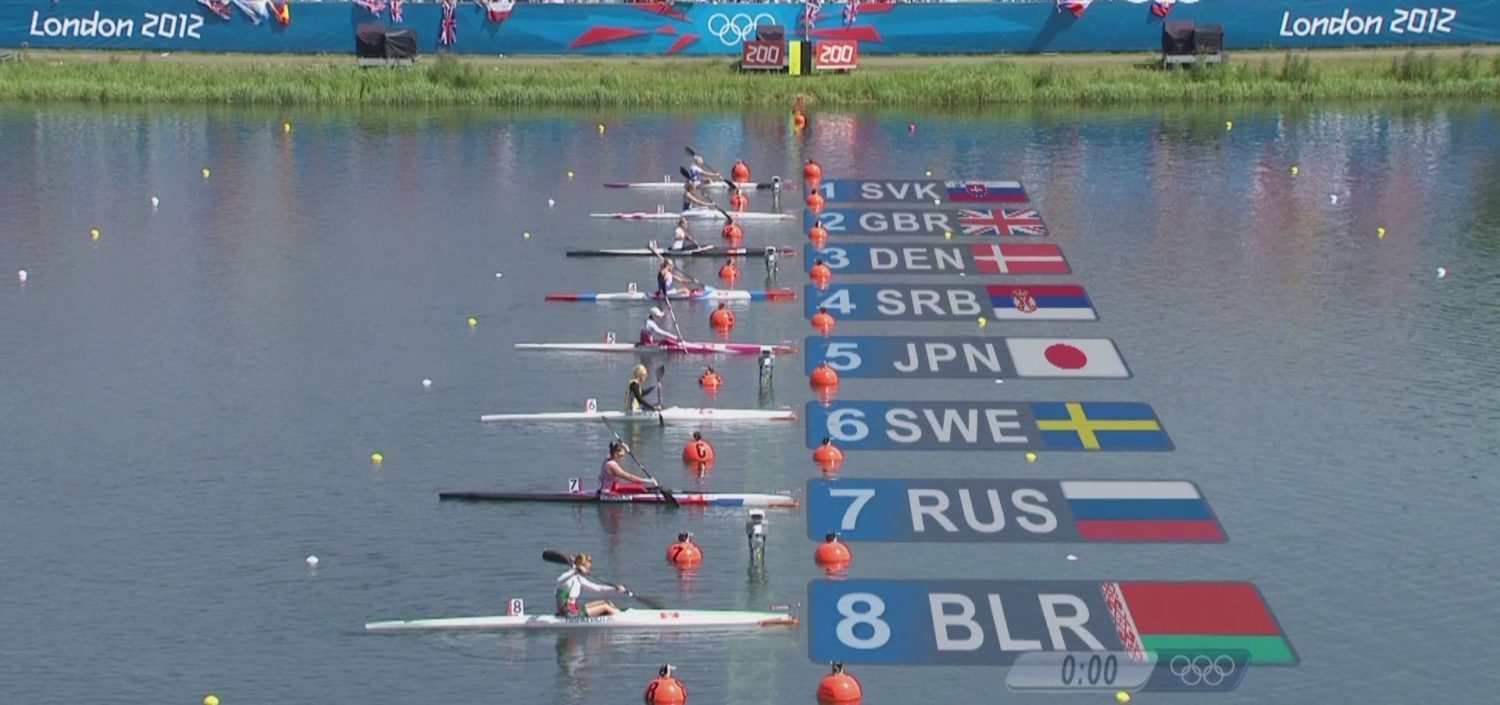
*Source: Brača-Sport
Slalom Canoe
Slalom, or Whitewater, racing is like downhill skiing, only athletes must navigate rough and fast-moving whitewater rapids and negotiate up to 25 hanging “gates” along the way, as fast as possible.
Slalom, or Whitewater, racing is like downhill skiing, only athletes must navigate rough and fast-moving whitewater rapids and negotiate up to 25 hanging “gates” along the way, as fast as possible.
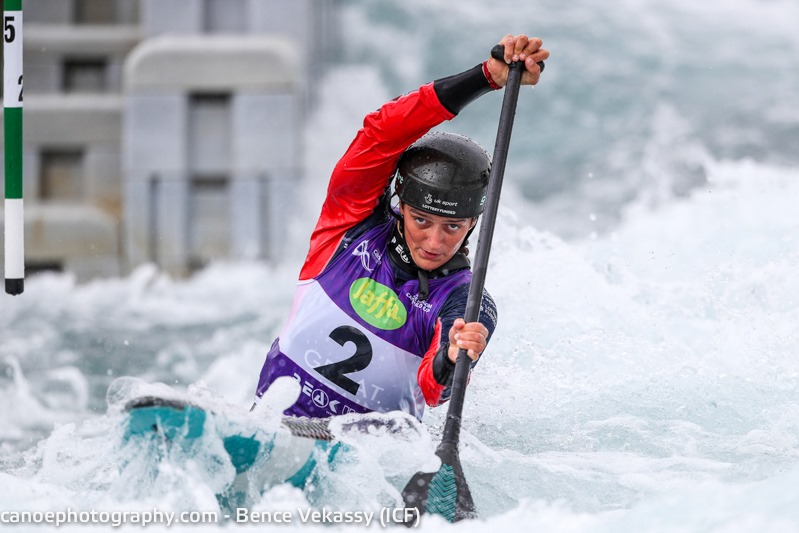 Slalom canoe/kayak racing was modeled from ski slalom and began in Switzerland in 1932. In its early days, it was first performed on flat water but later switched to white water rapids. The first World Championships were held in 1949 in Switzerland. The discipline made its Olympic debut during the 1972 Olympic Games in Munich, Germany. It was subsequently removed from the Olympic program then reinstated for the 1992 Olympic Games in Barcelona, Spain. A women’s canoe event (C1) was added to the 2010 ICF Canoe Slalom World Championships program for the first time ever, sixty-one (61) years after the sport debuted at the World Championships.
Slalom canoe/kayak racing was modeled from ski slalom and began in Switzerland in 1932. In its early days, it was first performed on flat water but later switched to white water rapids. The first World Championships were held in 1949 in Switzerland. The discipline made its Olympic debut during the 1972 Olympic Games in Munich, Germany. It was subsequently removed from the Olympic program then reinstated for the 1992 Olympic Games in Barcelona, Spain. A women’s canoe event (C1) was added to the 2010 ICF Canoe Slalom World Championships program for the first time ever, sixty-one (61) years after the sport debuted at the World Championships.
As of 2019, at the international level, there are four individual events (K1 – singles Women, K1 Men, C1 Women, and C1 Men). The C1 Women’s event will make its debut at the 2020 Olympic Games in Tokyo, Japan, replacing the men’s C2 (doubles canoe), which had been part of the Olympic program in 1972 and then from 1992 until 2016 and part of the World Championships program through 2017.
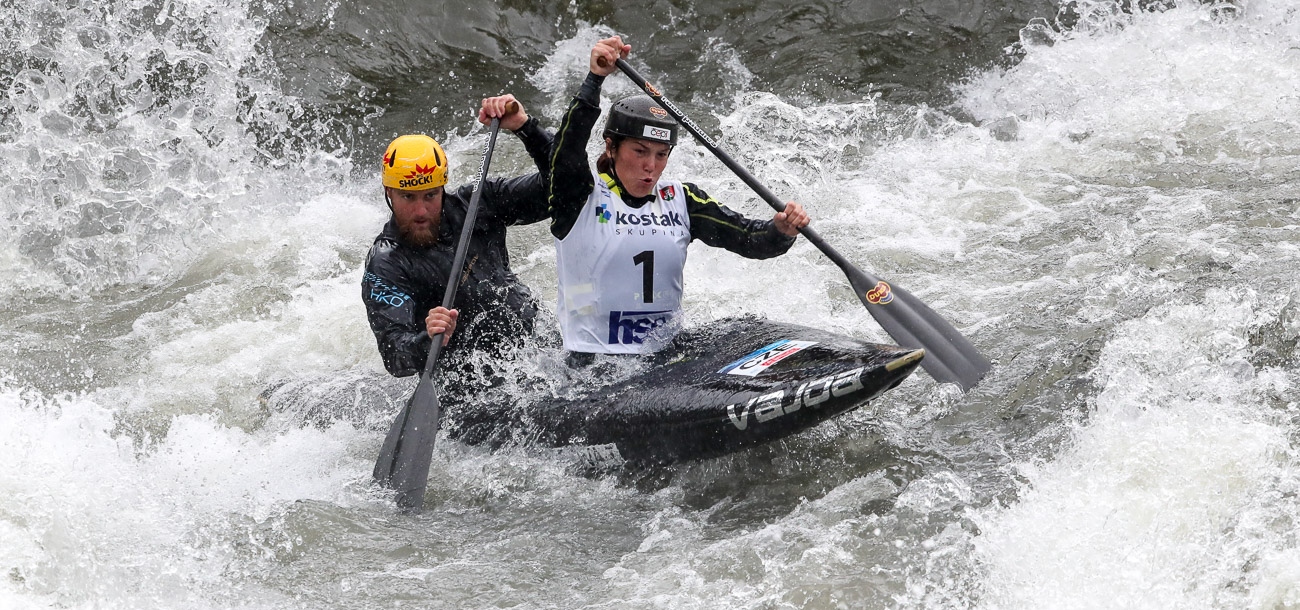 The Men’s C2 event was removed from the World Cup and World Championships program before the start of the 2018 season, in March 2018, in a decision by the International Canoe Federation and was replaced by the Mixed (male and female paddlers) C2 event, which is viewed as a possible future Olympic Slalom Canoe event.
The Men’s C2 event was removed from the World Cup and World Championships program before the start of the 2018 season, in March 2018, in a decision by the International Canoe Federation and was replaced by the Mixed (male and female paddlers) C2 event, which is viewed as a possible future Olympic Slalom Canoe event.
Women’s C1: 2019 ICF Canoe Slalom World Cup 1 – Women’s Final
*race starts at 1:30
Men’s Slalom Canoe Videos

This craft is a light, narrow, open and agile boat, allowing for significant maneuverability through the rapids and gates. There are one and two-person canoes. A spray skirt** is attached to the boat and partially covers the torso of the paddler to keep water out of the canoe.
*Source: GALASPORT
Athletes use a single-blade, straight-shaft paddle with a T-grip at the top of the shaft.

*Source: GALASPORT
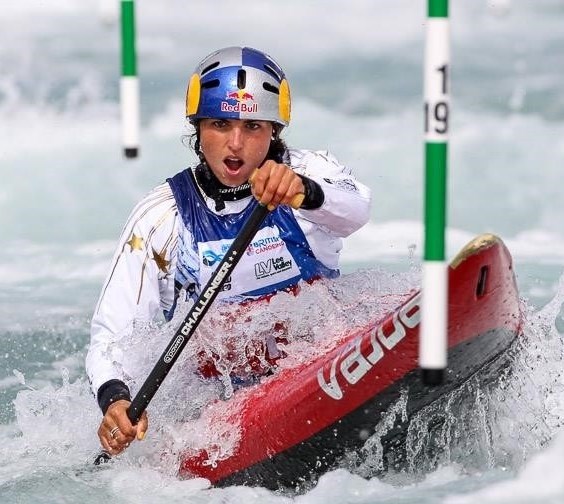 Canoe Slalom is contested by two types of boats: Canadian (“C”) canoe (C) and kayak (K). The discipline (and the Olympic sport) uses only the word “Canoe” based on historical nomenclature, however, the sport assumes the canoe and kayak sub-disciplines. The Tokyo 2020 Canoe sub-discipline includes two events on the Olympic program: C1 – singles for men and women. The Kayak sub-discipline includes two events on the Tokyo 2020 Olympic program: K1 – singles for men and women.
Canoe Slalom is contested by two types of boats: Canadian (“C”) canoe (C) and kayak (K). The discipline (and the Olympic sport) uses only the word “Canoe” based on historical nomenclature, however, the sport assumes the canoe and kayak sub-disciplines. The Tokyo 2020 Canoe sub-discipline includes two events on the Olympic program: C1 – singles for men and women. The Kayak sub-discipline includes two events on the Tokyo 2020 Olympic program: K1 – singles for men and women.
World Cup and World Championships events also include a Team competition for kayak and canoe, consisting of three K1 and three C1 boats, and combining times of all three team paddlers for overall team scores. This is not an Olympic event.
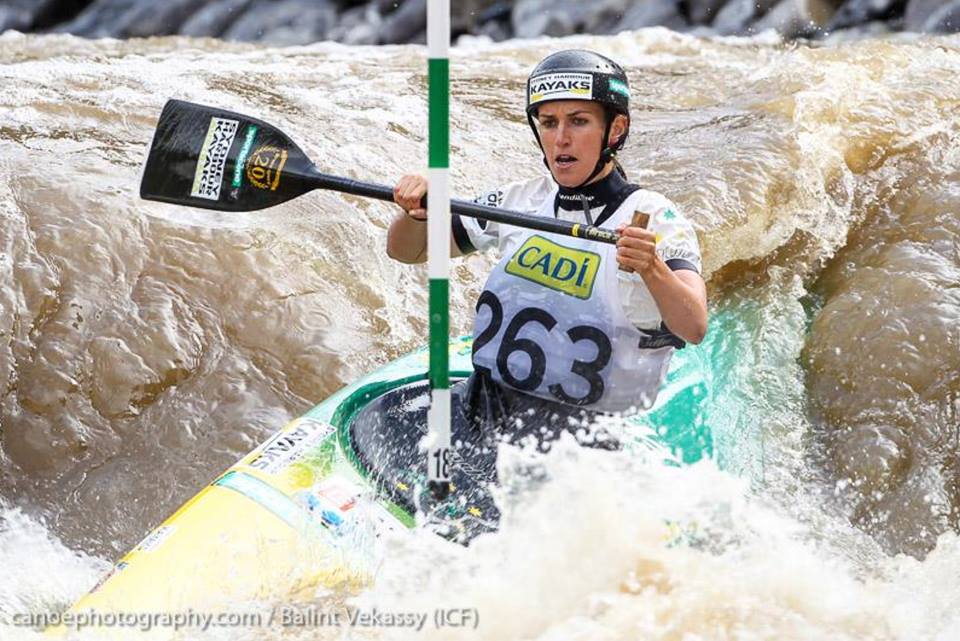 For “Canadian” Canoe Slalom, paddlers propel the canoes from a kneeling position, inside the cockpit, kneeling on both knees with feet underneath the body. All slalom paddlers wear a helmet and a personal flotation device (pfd) for safety. A spray skirt is a flexible covering fitted to the paddlers’ waist that encloses the cockpit of a canoe (or kayak) to ensure that the boat is waterproof.
For “Canadian” Canoe Slalom, paddlers propel the canoes from a kneeling position, inside the cockpit, kneeling on both knees with feet underneath the body. All slalom paddlers wear a helmet and a personal flotation device (pfd) for safety. A spray skirt is a flexible covering fitted to the paddlers’ waist that encloses the cockpit of a canoe (or kayak) to ensure that the boat is waterproof.
Athletes must navigate their boat down the rapids, through gates and around rocks or other barriers with the goal of crossing the finish line in the fastest time possible, and without penalties, or few penalties. The gates are two striped, dangling poles suspended just above the water from a wire stretched across the course.
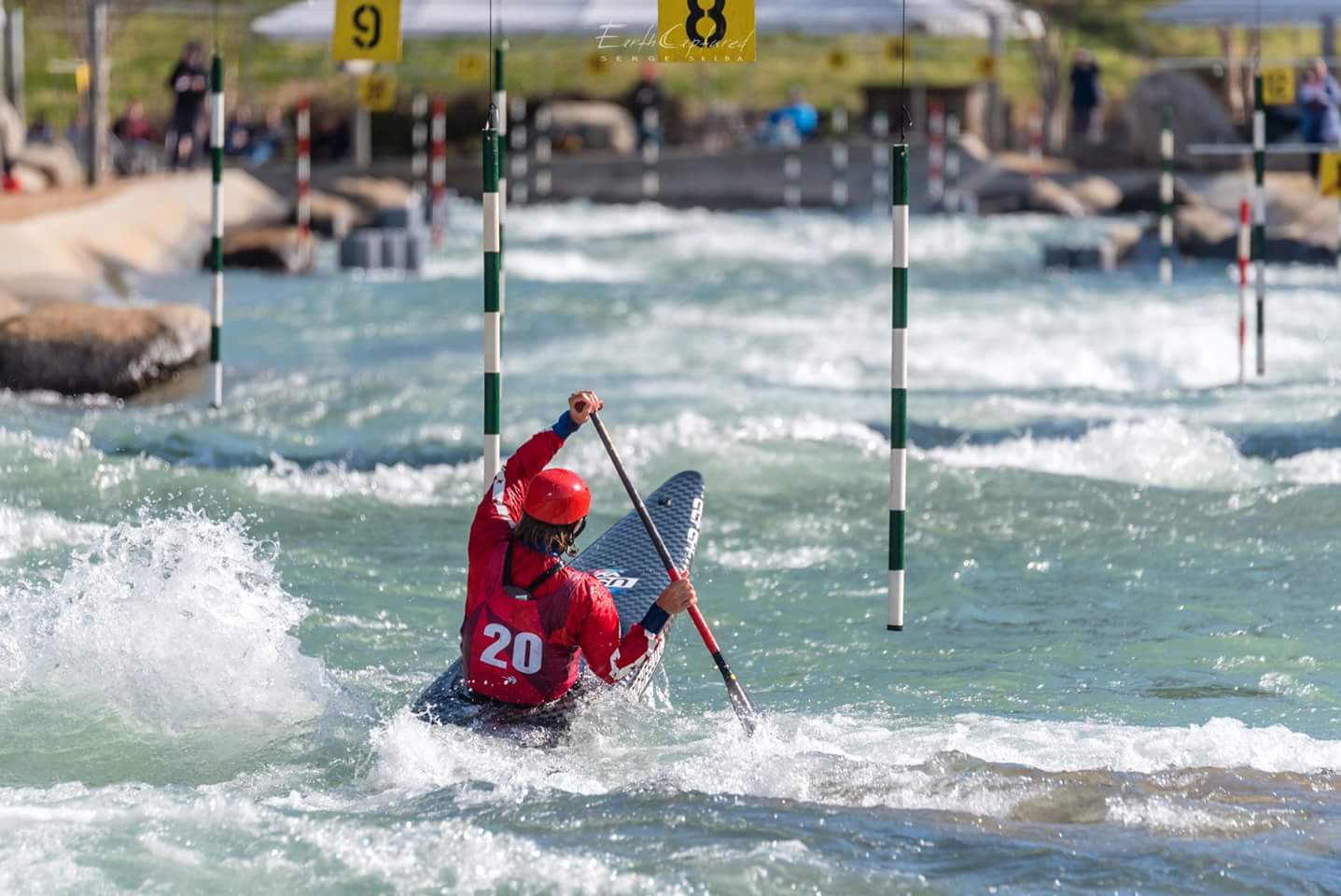 Canoe slalom is a timed event where competitors navigate a whitewater course by passing through a combination of upstream and downstream gates. Each course is different but can be a maximum of 300 meters in length and contain a maximum of 25 gates, with a minimum of six upstream gates. The type of gate is designated by color, red for upstream and green for downstream, indicating the direction they must be negotiated. Upstream gates are always placed in eddies, where the water is flat or moving slightly upstream. The paddler enters an eddy from the main current and paddles upstream through the gate. Downstream gates may also be placed in eddies, to increase the difficulty, and downstream gates in the current can be offset to alternating sides of the current, requiring rapid turns in fast-moving water.
Canoe slalom is a timed event where competitors navigate a whitewater course by passing through a combination of upstream and downstream gates. Each course is different but can be a maximum of 300 meters in length and contain a maximum of 25 gates, with a minimum of six upstream gates. The type of gate is designated by color, red for upstream and green for downstream, indicating the direction they must be negotiated. Upstream gates are always placed in eddies, where the water is flat or moving slightly upstream. The paddler enters an eddy from the main current and paddles upstream through the gate. Downstream gates may also be placed in eddies, to increase the difficulty, and downstream gates in the current can be offset to alternating sides of the current, requiring rapid turns in fast-moving water.
Courses are designed so the leading athletes will complete them in a time of between 90 and 110 seconds, though time penalties can be incurred for touching a gate (two seconds) and missing a gate (50 seconds).
Although many whitewater slalom events are still held on natural river courses, there is an increasing number of artificial whitewater courses being constructed and used for international competition around the world.
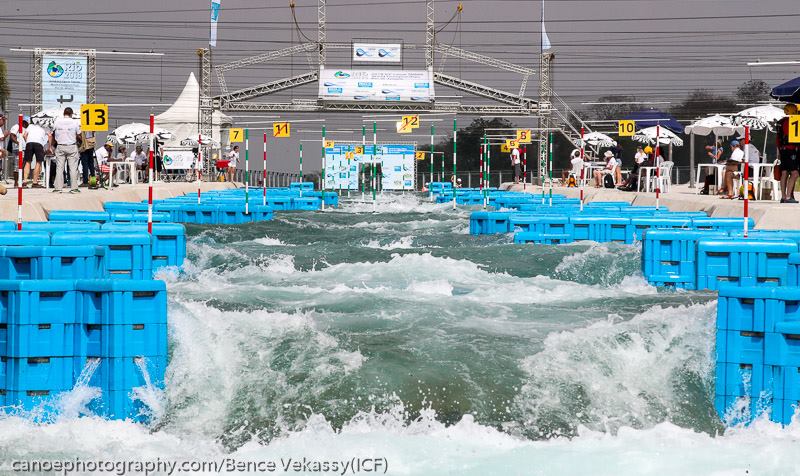
Slalom Kayak
Slalom, or Whitewater, racing is like downhill skiing, only athletes navigate through gates in rough, splashy, whitewater rapids. Slalom racing uses two types of boats, which are the two Olympic sub-disciplines: canoe and kayak.
Slalom, or Whitewater, racing is like downhill skiing, only athletes navigate through gates in rough, splashy, whitewater rapids. Slalom racing uses two types of boats, which are the two Olympic sub-disciplines: canoe and kayak.
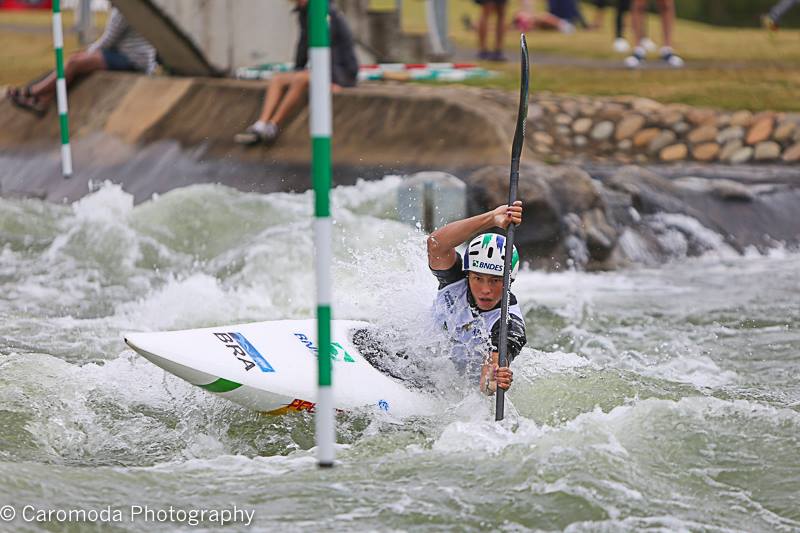 This craft is similar to the canoe, however, there are only one-person kayaks in competition, with the boat propelled by the paddler sitting inside the cockpit. The spray skirt is the same as in the canoe. All slalom paddlers wear a helmet and a personal flotation device (pfd) for safety.
This craft is similar to the canoe, however, there are only one-person kayaks in competition, with the boat propelled by the paddler sitting inside the cockpit. The spray skirt is the same as in the canoe. All slalom paddlers wear a helmet and a personal flotation device (pfd) for safety.
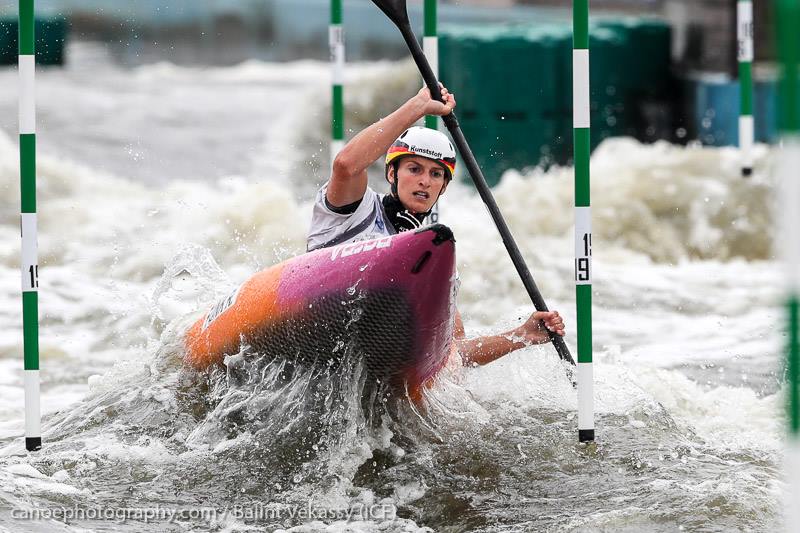 The Olympic Slalom Program includes singles (K1) kayak events for men and women. “K” stands for Kayak.
The Olympic Slalom Program includes singles (K1) kayak events for men and women. “K” stands for Kayak.
Women’s K1
Men’s Slalom Kayak Videos
- Men’s K1: 2019 ICF Canoe Slalom World Cup 1, Lee Valley
*race starts at 39:10
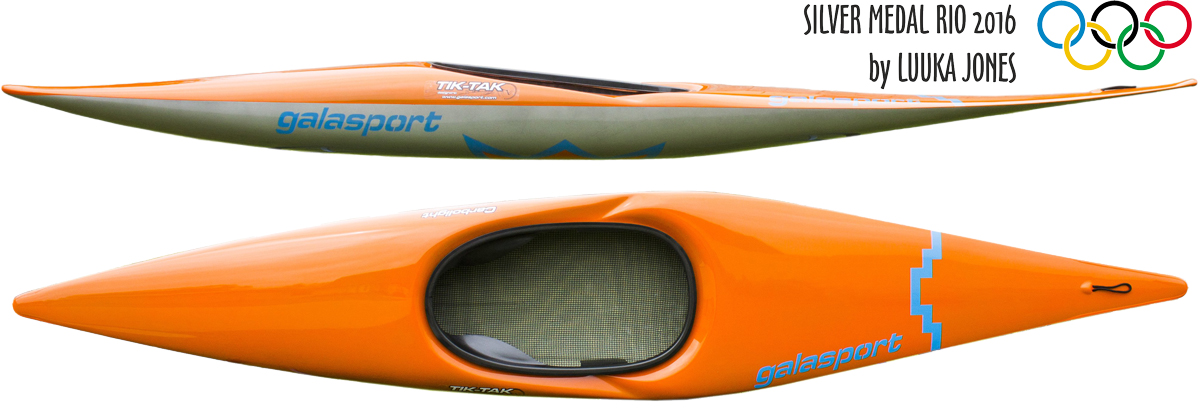
This craft is similar to the canoe, however, the boat propelled by the paddler sitting inside the cockpit. The spray skirt is the same as in the canoe.
See Planet Canoe for more information about Slalom.
*Source: GALASPORT
Paracanoe
Paracanoe is a paddling discipline for athletes with a physical impairment and races are contested by two types of boat, kayak (K) and va’a (V). Paracanoe began as an initiative by the International Canoe Federation (ICF) to allow athletes with an impairment to compete in the sport. Paracanoe (kayak events only) made its Paralympic debut at Rio 2016 with six medal events. For Tokyo 2020, there will nine medal events due to the inclusion of three Va’a class events.
Paracanoe is a paddling discipline for athletes with a physical impairment and races are contested by two types of boat, kayak (K) and va’a (V). Paracanoe began as an initiative by the International Canoe Federation (ICF) to allow athletes with an impairment to compete in the sport. Paracanoe (kayak events only) made its Paralympic debut at Rio 2016 with six medal events. For Tokyo 2020, there will nine medal events due to the inclusion of three Va’a class events.
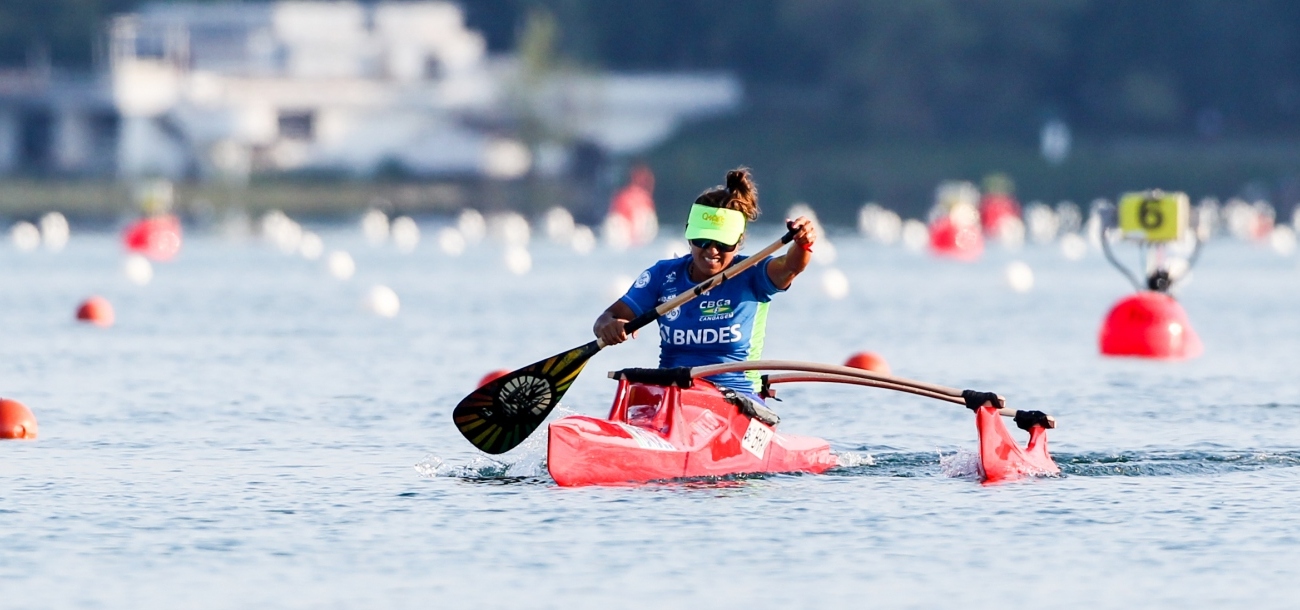 At the international level, both kayak and va’a have three different classes of event for men and women, depending on the classification of an athlete’s impairment, with KL1, KL2 and KL3 for kayak and VL1, VL2 and VL3 for va’a. All paracanoe/kayak races are individual events and competed on the same straight buoyed course as the sprint canoe and kayak events over 200 meters.
At the international level, both kayak and va’a have three different classes of event for men and women, depending on the classification of an athlete’s impairment, with KL1, KL2 and KL3 for kayak and VL1, VL2 and VL3 for va’a. All paracanoe/kayak races are individual events and competed on the same straight buoyed course as the sprint canoe and kayak events over 200 meters.
Paracanoe began as an initiative by the International Canoe Federation (ICF) to allow athletes with an impairment to compete in the sport. The discipline featured with exhibition status under the name paddleability at the 2009 ICF Canoe Sprint World Championships in Dartmouth, NS, Canada, and was given official status as paracanoe at the following year’s edition in Poznan, Poland. Later in 2010, the International Paralympic Committee (IPC) announced at a meeting in Guangzhou, People’s Republic of China, that paracanoe would make its debut at the Paralympic Games in 2016 in Rio de Janeiro. There will be six medal events at the Games (three men, three women), all in the kayak category. See more at the ICF website.
 Paracanoe (kayak events only) made its Paralympic debut at Rio 2016 with six medal events. For Tokyo 2020, there will be nine medal events due to the inclusion of three Va’a class events. See the ICF website.
Paracanoe (kayak events only) made its Paralympic debut at Rio 2016 with six medal events. For Tokyo 2020, there will be nine medal events due to the inclusion of three Va’a class events. See the ICF website.
Overview of Paracanoe/parakayak at the ICF Sprint World Championships
VL2 Women’s 200 meter: Final 2019 ICF Canoe Sprint World Cup 1, Poznan, Poland
*race starts at 2:57:15

Paracanoe (Va’a)
The va’a is an outrigger canoe which has an ama (second pontoon) as a support float and is used with a single-blade paddle.
*Source: Plastex Boats
There are numerous options for Va’a paddles and are based on personal preference/needs of the paddler. Examples include:
Parakayak
The kayak is propelled by a double-blade paddle and has a rudder. Paracanoe began as an initiative by the International Canoe Federation (ICF) to allow athletes with an impairment to compete in the sport. Paracanoe (kayak events only) made its Paralympic debut at Rio 2016 with six medal events. For Tokyo 2020, there will nine medal events due to the inclusion of three Va’a class events.
The kayak is propelled by a double-blade paddle and has a rudder. Paracanoe began as an initiative by the International Canoe Federation (ICF) to allow athletes with an impairment to compete in the sport. Paracanoe (kayak events only) made its Paralympic debut at Rio 2016 with six medal events. For Tokyo 2020, there will nine medal events due to the inclusion of three Va’a class events.
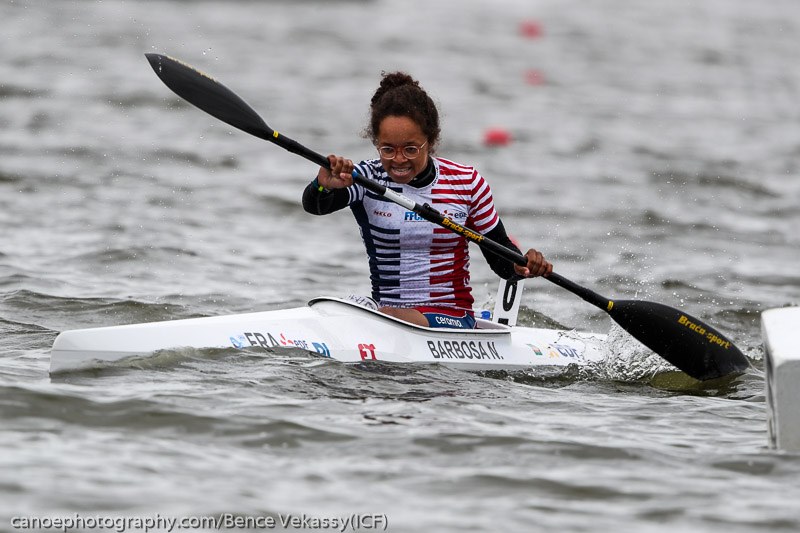 At the international level, both kayak and va’a have three different classes of event for men and women, depending on the classification of an athlete’s impairment, with KL1, KL2 and KL3 for kayak and VL1, VL2 and VL3 for va’a. All paracanoe/kayak races are individual events and competed on the same straight buoyed course as the sprint canoe and kayak events over 200 meters.
At the international level, both kayak and va’a have three different classes of event for men and women, depending on the classification of an athlete’s impairment, with KL1, KL2 and KL3 for kayak and VL1, VL2 and VL3 for va’a. All paracanoe/kayak races are individual events and competed on the same straight buoyed course as the sprint canoe and kayak events over 200 meters.
Paracanoe began as an initiative by the International Canoe Federation (ICF) to allow athletes with an impairment to compete in the sport. The discipline featured with exhibition status under the name paddleability at the 2009 ICF Canoe Sprint World Championships in Dartmouth, NS, Canada, and was given official status as paracanoe at the following year’s edition in Poznan, Poland. Later in 2010, the International Paralympic Committee (IPC) announced at a meeting in Guangzhou, People’s Republic of China, that paracanoe would make its debut at the Paralympic Games in 2016 in Rio de Janeiro. There will be six medal events at the Games (three men, three women), all in the kayak category. See more at the ICF website.
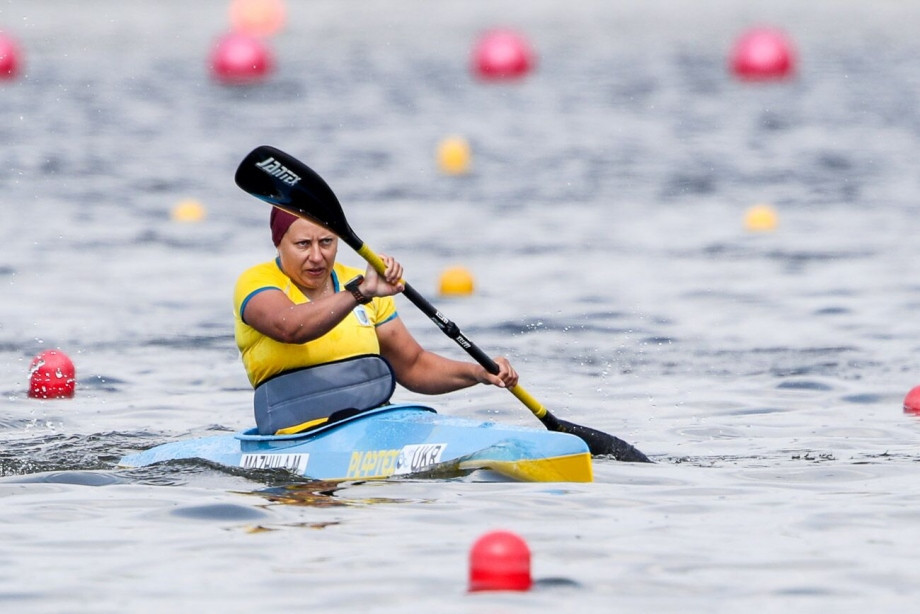 Paracanoe (kayak events only) made its Paralympic debut at Rio 2016 with six medal events. For Tokyo 2020, there will be nine medal events due to the inclusion of three Va’a class events. See the ICF website.
Paracanoe (kayak events only) made its Paralympic debut at Rio 2016 with six medal events. For Tokyo 2020, there will be nine medal events due to the inclusion of three Va’a class events. See the ICF website.
Overview of Paracanoe/parakayak at the ICF Sprint World Championships
KL1 Women’s 200 meters: 2019 ICF Canoe Sprint World Cup 1, Poznan, Poland
*race starts at 1:23:00
Contact Us
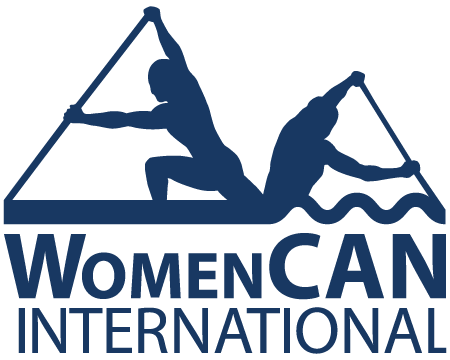
WomenCAN International
Equal Opportunities for Women in Olympic Canoe Racing
Pamela Boteler, President info@womencanintl.com





